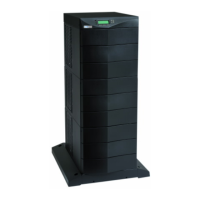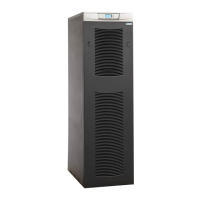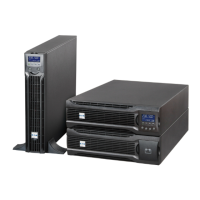INTRODUCTION
Eaton 9395 UPS (450–825 kVA) Installation and Operation Manual S 164201725 Rev 4 www.eaton.com/powerquality
1-7
1.2.10 Variable Module Management System and High Alert Modes
NOTE The Variable Module Management System and Energy Saver System modes are mutually exclusive.
The Variable Module Management System (VMMS) mode maintains UPM
redundancy and achieves higher efficiencies by intelligently controlling the UPM’s
load level. The efficiency rating for each UPM is highest when loads are greater than
50% of the system rating. Therefore, shifting the load to fewer UPMs can achieve
higher efficiencies when the UPS load is lighter.
In VMMS mode, the UPS is actively monitoring the critical bus and UPMs are
available to assume load in less than 2 ms to respond to load changes.
The VMMS feature has three configurable modes of operation: Online mode, Online
mode with VMMS, and High Alert mode. All modes are selectable from the front
panel.
VMMS mode supports both distributed bypass and SBM parallel configurations.
In High Alert mode, all idle UPMs go online for one hour. At the completion of the
hour, the UPS defaults back to VMMS mode. If the High Alert command is received
during the one hour, the one hour timer will be restarted.
1.2.11 Monitoring and Communication
S Remote Monitor Panel II (RMP II) – An optional RMP II contains backlit status
indicators and a local horn, allowing monitoring of the operational status and alarm
condition of the UPS from virtually any location within the facility.
S Relay Interface Module II (RIM II) – An optional RIM II uses relay contact closures to
indicate the UPS operating status and alarm condition.
S Supervisory Contact Module II (SCM II) – An optional SCM II establishes an interface
between the UPS system equipment and the customer's monitor.
S X-Slot Cards – Optional X-Slot cards support several protocols, such as SNMP,
HTTP, IBM
®
AS/400
®
, and Modbus
®
.
S eNotify Remote Monitoring and Diagnostics Service – An optional service that provides
24/7 remote monitoring of 43 alarms, temperature/humidity and battery charge
information, daily heartbeat check, and monthly report. The service also provides
customer notification of significant alarms, remote diagnostics, and dispatch of
technicians. A ConnectUPS -X Web/SNMP Card is required in an X-Slot
communication bay. An optional Environmental Monitoring Probe (EMP) is required
for temperature/humidity monitoring.
See Chapter 8, “Communication,” for additional information on monitoring and
communication features.
t

